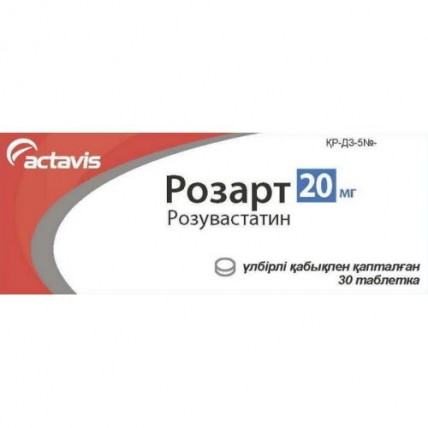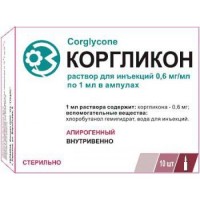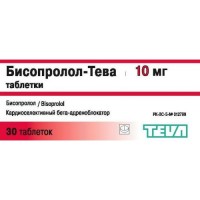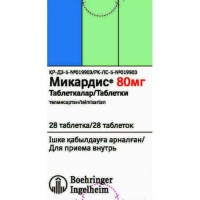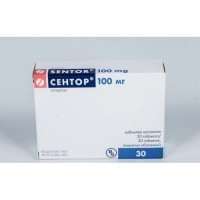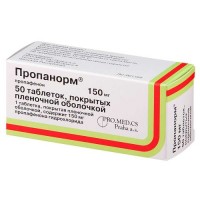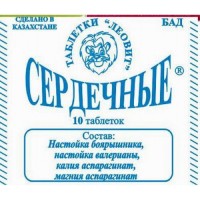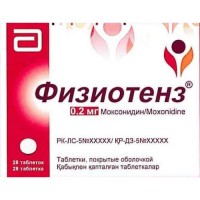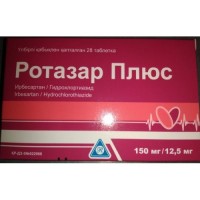Rozart 30s 20 mg film-coated tablets
- $27.80
Rozart
the Trade name
Rozart
Mezhdunarodnoye the unlicensed
name Rosuvastatin Dosage Form
of the Tablet, film coated, 5 mg, 10 mg, 20 mg and 40 mg
Structure
One tablet contains
active agent: rosuvastatin of calcium of 5.21 mg, 10.42 mg, 20.84 or 41.68 mg it is equivalent rosuvastatin of 5 mg, 10 mg, 20 mg and 40 mg respectively.
excipients: cellulose microcrystalline (type 102), krospovidon (type A), calcium hydrophosphate dihydrate, lactoses monohydrate, magnesium stearate,
structure of a cover:
5 mg
of Opadray of II 33G28435 White (gipromelloza 2910, titan dioxide (E 171), lactoses monohydrate, macrogoal 3350, triacetin)
10 mg, 20 mg and 40 mg
of Opadray of II 33G240007 Pink (gipromelloza 2910, titan dioxide (E171), lactoses monohydrate, macrogoal 3350, triacetin, carmine (E 120)).
The description
of the Tablet of round shape, with a biconvex surface, film coated white color, with an engraving of ST 1 on one party, with a diameter about 5.5 mm (for a dosage of 5 mg).
Tablets of round shape, with a biconvex surface, film coated pink color, with an engraving of ST 2 on one party, with a diameter about 7.0 mm (for a dosage of 10 mg).
Tablets of round shape, with a biconvex surface, film coated pink color, with an engraving of ST 3 on one party, with a diameter about 9.0 mm (for a dosage of 20 mg).
Tablets of an oval form, with a biconvex surface, film coated pink color, with an engraving of ST 4 on one party, 16.0 mm long and 8.0 mm wide (for a dosage of 40 mg).
Pharmacotherapeutic group
Hypolipidemic drugs of HMG-CoA reductase inhibitors
Rosuvastatin.
The ATX C10A A07 code
the Pharmacological
Pharmacokinetics Rosuvastatin properties is a selection, competitive inhibitor
of HMG-CoA reductase - the enzyme turning 3-hydroxy-3-metilglutarilkoenzim A in mevalonat, the predecessor of cholesterol.
The maximum concentration of rosuvastatin in blood plasma is reached approximately in 5 hours after oral administration. The absolute bioavailability is about 20%. Rosuvastatin is absorbed mainly by a liver which is the main place of synthesis of cholesterol and clearance of Hs-LPNP. The volume of distribution of rosuvastatin is about 134 l. About 90% of rosuvastatin contact proteins of blood plasma, generally albumine. Rosuvastatin is exposed to limited metabolism (about 10%). The metabolism researches in vitro with use of hepatocytes of the person specify that rosuvastatin is non-core substrate for metabolism by enzymes of a system of P450 cytochrome. CYP2C9 is the main isoenzyme participating in metabolism. Isoenzymes 2C19, 3A4 and 2D6 are involved in metabolism to a lesser extent. The main revealed metabolites of rosuvastatin are N-desmetil and lactonic metabolites. N-desmetil metabolite for about 50% is less active, than rosuvastatin, lactonic metabolites are pharmacological not active. More than 90% of pharmacological activity on inhibition of the circulating GMG-KoA-reduktazy are provided with rosuvastatin.
About 90% of a dose of rosuvastatin are removed in not changed view from an organism through intestines (including the absorbed and not absorbed active substance of rosuvastatin), the rest is removed with urine. About 5% are removed in not changed view with urine. Plasma elimination half-life of blood makes about 19 hours. Elimination half-life does not increase at use of higher doses of drug. The average geometrical plasma clearance is about 50 l/h (coefficient of variation of 21.7%). As well as in a case with other inhibitors of GMG-KoA-reduktazy, the membrane carrier of cholesterol - the transport protein From organic anions (OATP-C) which is carrying out a big role in rosuvastatin removal by a liver is involved in process of hepatic capture of rosuvastatin.
System exposure of rosuvastatin increases in proportion to a dose. Changes of pharmacokinetic parameters at administration of drug several times in day are not noted.
The pharmacodynamics
Rozart reduces the increased content of cholesterol-LDL, general cholesterol, triglycerides (TG), increases cholesterol content - lipoproteins of the high density (HS-LPVP). It also reduces apolipoprotein B content (ApoV), Hs-neLPVP (content of the general cholesterol minus LPVP cholesterol content), HS-LPONP, TG-LPONP and increases the level of A-I apolipoprotein (ApoA-I). Rozart reduces ratio Hs-LPNP/HS-LPVP, the general Hs/Hs-LPVP, Hc-neLPVP/Hs-LPVP and ApoV/ApoA-I.
The therapeutic effect is reached within one week after an initiation of treatment and in 2 weeks reaches 90% of the greatest possible effect. Usually greatest possible therapeutic effect is reached in 4 weeks and maintained at further administration of drug.
Rozart is effective at treatment of adult patients with a hypercholesterolemia with or without gipertriglitseridemiya symptoms, regardless of their race, a floor or age and also at treatment of special category of patients, such as patients with diabetes or patients with a hereditary form of a family hypercholesterolemia.
Indications
- primary hypercholesterolemia (the IIa type, including a family heterozygous hypercholesterolemia) or the mixed dislipidemiya (IIb type) as addition to a diet when the diet and other non-drug methods of treatment (for example, physical exercises, decrease in body weight) are insufficient
- a family homozygous hypercholesterolemia - as addition to a dietotherapy and other methods of lipidosnizhayushchy therapy (for example, LPNP-aferez), or in cases when similar therapy is insufficiently effective
- prevention warmly - vascular complications at adult patients with the increased risk of developing an atherosclerotic cardiovascular disease as auxiliary therapy
the Route of administration and doses
Prior to the beginning of and during therapy by Rozart the patient has to keep to a standard hypolipidemic diet. The drug Rozart can be taken at any time, irrespective of meal. The dose has to be selected individually according to the purpose of therapy and the response of the patient to treatment. The recommended initial dose for the patients beginning to take the drug or for the patients transferred from intake of other inhibitors of HMG-CoA reductase has to make 5 or 10 mg of Rozart of 1 times a day. When choosing an initial dose of drug, it is necessary to consider the level of cholesterol and possible risk of development of cardiovascular complications and also potential risk of development of side effects. In case of need, the dose can be increased after 4 weeks of administration of drug. Due to the possible development of side effects at reception of a dose of 40 mg, increase in a dose to the maximum 40 mg can be considered only at patients with a heavy hypercholesterolemia and with high risk of cardiovascular complications (especially at patients with a family hypercholesterolemia) at which the desirable result of therapy at reception of a dose of 20 mg was not achieved. Observation of the patients receiving drug in a dose of 40 mg is recommended.
Prevention of cardiovascular complications
the Recommended dose - 20 mg once a day.
Use for elderly patients
Elderly patients
is not required to dose adjustment. To patients 70 years are more senior the initial dose of drug of 5 mg is recommended.
Patients with a renal failure
with a renal failure easy or moderate severity dose adjustment is not required From patients. The recommended initial dose of drug of 5 mg. At patients with moderate renal failures (clearance of creatinine less than 60 ml/min.) - use of drug in a dosage of 40 mg is contraindicated. At patients with the profound renal failure (clearance of creatinine less than 30 ml/min.) - drug Rozart use is contraindicated.
Dosing at patients with a liver failure
At patients with a liver failure of 7 points and below on a scale of Chayld-Pyyu is not revealed increases in system influence of rosuvastatin. However at patients with a liver failure of 8 and 9 points on a scale of Chayld-Pyyu the increased system influence of drug was noted (at these patients it is necessary to control function of kidneys. There is no experience of use for patients with a liver failure more than 9 points on a scale of Chayld-Pyyu.
Ethnic groups
When studying the pharmacokinetic researches Rozarta at the patients belonging to different ethnic groups approximately double increase in average AUC and Cmax value of rosuvastatin was noted. At patients of Mongoloid race the increase in system influence (Japanese, Chinese, Filipinos, Vietnamese and Koreans), in comparison with representatives of Caucasian race is noted, at the Indian patients the increase in average AUC and Cmax value approximately by 1.3 times was noted. The analysis of pharmacokinetic parameters for all studied population did not reveal clinically significant differences in drug pharmacokinetics among representatives of Caucasian and negroid races.
It is necessary to consider this fact when prescribing rosuvastatin to these groups of patients. The recommended initial dose for patients of Mongoloid race makes 5 mg.
The patients predisposed to a myopathy
prescribing of drug in a dose of 40 mg is contraindicated to patients with the factors predisposed to development of a myopathy. The recommended initial dose for this group of patients makes 5 mg.
Side effects
the Frequency of side effects is ranged as follows: Often (> 1/100 to
Often (> 1/100 to
- a headache, dizziness
- nausea, a constipation, an abdominal pain
- myalgia
- an asthenia
- diabetes
Infrequently (≥ 1/1000 to
- an itching, rash and urticaria
Seldom (> 1/10,000,
- hypersensitivity reactions, including a Quincke's disease
- a myopathy (including a miositis) and a rhabdomyolysis
- increase in level of hepatic transaminases, pancreatitis
Very seldom (
-jaundice, hepatitis
- polyneuropathy
- memory loss
- a hamaturia
- arthralgias
- a depression, sleep disorders
- sexual dysfunction
Isolated cases
- interstitial diseases of lungs
of not specified frequency
- diarrhea
- the immunomediated necrotizing myopathy
- cough, short wind
- Stephens-Johnson's syndrome
- the gynecomastia
- peripheral hypostases
At the patients receiving Rozart can come to light a proteinuria. In most cases the proteinuria decreases or disappears in the course of therapy and does not mean emergence sharp or progressing of the existing disease of kidneys. As well as at use of other inhibitors of GMG-KoA-reduktazy, the frequency of emergence of side effects has dose-dependent character.
Contraindications
- hypersensitivity to rosuvastatin or to any of excipients
- a liver disease in an active phase, including the inexplicable, permanent increase in level of serumal transaminases and any increase in level of serumal transaminases exceeding more than by 3 times an upper limit of norm (VGN)
- heavy renal insufficiency (
-myopathies
- a concomitant use of cyclosporine
- pregnancy, the lactation period, lack of adequate methods of contraception at women of childbearing age
- predisposition to development of miotoksichesky complications
- hereditary intolerance of a galactose, a lactose intolerance or a sprue of glucose and a galactose
- children's and teenage age up to 18 years
For a dosage of 40 mg
- moderate renal failures (clearance of creatinine less than 60 ml/min.)
- a hypothyroidism
- the personal or family anamnesis of hereditary muscular diseases
- muscular toxicity against the background of intake of other inhibitors of GMG-KoA-reduktazy or fibrat in the anamnesis
- states which can lead to increase in concentration of rosuvastatin in blood plasma
- patients of Asian origin
- a concomitant use of fibrat
- an alcohol abuse
Medicinal interactions
Cyclosporine
Simultaneous use leads clearance of creatinine to increase in concentration of Rozart in blood plasma by 7 times. Does not affect plasma concentration of cyclosporine.
Antagonists of vitamin K
the Beginning of therapy by Rozart or increase in a dose of drug at the patients receiving at the same time antagonists of vitamin K (for example, warfarin), can lead to increase in a prothrombin time. Cancellation or a dose decline of rosuvastatin can cause reduction of MHO. In such cases it is necessary to carry out monitoring of MHO.
Gemfibrozil and other hypolipidemic products
Simultaneous use of Rozart and a gemfibrozil led to increase twice in the maximum concentration of rosuvastatin in blood plasma (Cmax) and AUC rosuvastatin
based on data on specific interaction, significant interaction from fenofibrata, perhaps pharmakodinamichesky interaction is not expected pharmacokinetically. Gemfibrozil, fenofibrat, other fibrata and Niacinum (niacin) in lipidosnizhayushchy doses (1 g or more in day) at a concomitant use with inhibitors of GMG-KoA-reduktazy increased risk of emergence of a myopathy, it is possible because they can cause a myopathy and at inclusion in monotherapies. The concomitant use of rosuvastatin in a dose of 40 mg and fibrat is contraindicated. At these patients the initial dose should not exceed 5 mg
of Ezetimib
At simultaneous use Rozart and the ezetimib was not observed changes of AUC or Cmax of both drugs. However, it is impossible to exclude pharmakodinamichesky interaction between Rozart and ezetimiby, capable to cause the undesirable phenomena
Inhibitors of proteases
In spite of the fact that the exact mechanism of interaction is not known, joint intake of inhibitors of proteases can lead to significant increase in exposure of rosuvastatin. In a pharmacokinetic research, at a concomitant use of rosuvastatin in a dose of 20 mg and the combined drug containing two inhibitors of proteases (400 mg of a lopinavir of/100 mg of a ritonavir) healthy volunteers the increase twice in value of equilibrium AUC(0-24), and by 5 times of Cmax of rosuvastatin, respectively is revealed. Thus, simultaneous use of rosuvastatin for the sick HIV receiving protease inhibitors is not recommended
Antacids
Simultaneous use of Rozart and suspensions of the antacids containing aluminum and magnesium hydroxide leads to decrease in plasma concentration of rosuvastatin approximately for 50%. This effect is significant more weakly if antacids are applied in 2 hours after intake of rosuvastatin.
The clinical importance of this interaction is not studied.
Erythromycin
leads Simultaneous use of Rozart and erythromycin to reduction of AUC(0-t) of rosuvastatin by 20% and Cmax of rosuvastatin by 30%. Similar interaction can result from strengthening of motility of the intestines caused by intake of erythromycin.
Oral contraceptives / the replacement hormonal therapy (RHT) increases Simultaneous use of rosuvastatin and oral contraceptives AUC ethinylestradiol and AUC Norgestrelum by 26% and 34% respectively. Such increase in plasma concentration should be considered when choosing a dose of oral contraceptives. There are no pharmacokinetic data at the persons who are at the same time taking rosuvastatin and the drugs of gormonozamestitelny therapy therefore it is impossible to exclude similar effect when using this combination. However such combination of drugs was rather widely used by women during clinical trials and well transferred.
Digoxin
is not expected clinically significant interaction of rosuvastatin with digoxin.
P450 cytochrome enzymes
Rosuvastatin is not either inhibitor, or the inductor of enzymes of P450 cytochrome. Besides, rosuvastatin is weak substrate for these enzymes. Clinically significant interaction between rosuvastatin, flukonazoly (CYP2C9 and CYP3A4 inhibitor) and ketokonazoly was not noted (CYP2A6 CYP3A4 inhibitor). Combined use of Rozart and an itrakonazol (CYP3A4 inhibitor) increases AUC rosuvastatin by 28% Thus, the interaction connected with P450 cytochrome metabolism is not expected.
Special instructions
With care
For doses less than 40 mg: the personal or family anamnesis of hereditary muscular diseases and the previous anamnesis of muscular toxicity when using other inhibitors of GMG-KoA-reduktazy or fibrat, excessive alcohol intake, a hypothyroidism, race (Asian race), co-administration from fibrata.
Presence of risk of developing a myopathy/rhabdomyolysis - a renal failure, age is more senior than 65 years, states at which increase in plasma concentration of rosuvastatin, liver diseases in the anamnesis, sepsis, arterial hypotension, extensive surgical interventions, injuries, heavy metabolic, endocrine or electrolytic disturbances or uncontrollable epilepsy is noted.
At the patients accepting high doses of Rozart, in particular 40 mg the proteinuria, mainly tubular, revealed by a test method by means of an indicator strip, in most cases passing or periodic was noted. It is necessary to consider assessment of renal function during the subsequent observation of the patients accepting a dose of 40 mg.
From the musculoskeletal system
At Rozart's use in all dosages and, in particular, at reception of the doses of drug exceeding 20 mg it was reported about the following impacts on the musculoskeletal system: myalgia, myopathy, in rare instances rhabdomyolysis.
Definition of a kreatinfosfokinaza
Definition of a kreatinfosfokinaza (KFK) should not be carried out after intensive physical activities or in the presence of other possible reasons of increase in KFK that can lead to incorrect interpretation of the received results. If the KFK initial level is significantly increased (5 times higher, than the upper bound of norm), in 5–7 days it is necessary to take repeated measurement. It is not necessary to begin therapy if the repeated test confirms the KFK initial level (more than 5 times higher in comparison with the upper bound of norm).
It is necessary to inform the patient on need of the immediate message to the doctor about cases of unexpected appearance of muscular pains, muscle weakness or spasms, especially in combination with an indisposition and fever. At such patients it is necessary to determine the KFK level. Therapy has to be stopped if the KFK level is considerably increased (more than by 5 times in comparison with the upper bound of norm) or if symptoms from muscles are pronounced and cause daily discomfort (even if the KFK level is 5 times less in comparison with the upper bound of norm). If symptoms disappear and the KFK level returns to norm, it is necessary to consider a question of repeated appointment of Rozart or other inhibitors of GMG-KoA-reduktazy in smaller doses at careful observation of the patient. Routine control of KFK in the absence of symptoms is not reasonable.
Signs of increase in impact on skeletal muscles at Rozart's reception and the accompanying therapy are noted. It was reported about increase in number of cases of a miositis and a myopathy at the patients accepting other inhibitors of GMG-KoA-reduktazy in combination with derivatives of fibrinous acid, including gemfibrozit, cyclosporine, niacin, azolny antifungal means, inhibitors of proteases and makrolidny antibiotics. Gemfibrozil increases risk of emergence of a myopathy at the combined appointment with some inhibitors of GMG-KoA-reduktazy. Thus, co-administration of Rozart and a gemfibrozil is not recommended. The ratio of risk and possible advantage at combined use of Rozart and fibrat or Niacinum has to be carefully weighed.
In 2-4 weeks after an initiation of treatment and/or at increase in a dose of Rozart the control of indicators of lipidic exchange is necessary (if necessary dose adjustment is required).
A liver
As well as other inhibitors of GMG-KoA-reduktazy, Rozart it is necessary to apply with care at patients who take excessive amount of alcohol and/or have in the anamnesis of a disease of a liver.
It is recommended to carry out definition of indicators of function of a liver prior to therapy and in 3 months after an initiation of treatment. If the level of transaminases in blood serum by 3 times exceeds the upper bound of norm, it is necessary to stop Rozart's reception or to reduce the accepted dose. At patients with the secondary hypercholesterolemia caused by a hypothyroidism or a nephrotic syndrome, therapy of a basic disease has to be carried out prior to treatment by Rozart.
Ethnic groups
during the pharmacokinetic researches among patients of Asian race the increase in system concentration of rosuvastatin in comparison with the indicators received among patients of Caucasian race is noted.
Protease inhibitors
Simultaneous use with inhibitors of protease is not recommended.
An interstitial disease of lungs
Exclusively exceptional cases of an interstitial disease of lungs were registered at intake of some statines, especially at prolonged use of drugs. The described symptoms can include short wind, dry cough and the general aggravation of symptoms (fatigue, loss of weight and fever). In case of suspicion on development in the patient of an interstitial disease of lungs, therapy by statines has to be stopped.
Patients with rare hereditary problems of intolerance of a galactose, deficiency of lactase of falls (Sami) or glyukozo-galaktozny malabsorption should not accept a lactose intolerance Rozart.
Diabetes
At patients with glucose level in blood on an empty stomach from 5.6 to 6.9 mmol/l, therapy by rosuvastatin was associated with the increased risk of developing diabetes.
Features of influence of medicine on ability to run the vehicle or potentially dangerous mechanisms
When driving or other mechanisms, it is necessary to consider that during therapy there can be dizziness.
Overdose
Symptoms - expressiveness of symptoms of side effects.
Treatment - symptomatic and the supporting actions. Control of function of a liver and the KFK level is necessary. It is improbable that the hemodialysis will be effective.
Packing and a form of release
On 10 tablets pack into blister strip packaging from a film of PVH/PVDH and aluminum foil. On 3 blister strip packagings together with the instruction for medical use in the Russian and state languages place in a cardboard pack.
To Store storage conditions at a temperature not over 25 of 0C
to Store in places inaccessible for children!
2 years
not to apply a period of storage after an expiration date.
Prescription status
According to the prescription
of Proizvoditel Aktavis Ltd, B 16 industrial zone, Zeytun ZTN 08, Malta
to Develop
the Trade name
Rozart
Mezhdunarodnoye the unlicensed
name Rosuvastatin Dosage Form
of the Tablet, film coated, 5 mg, 10 mg, 20 mg and 40 mg
Structure
One tablet contains
active agent: rosuvastatin of calcium of 5.21 mg, 10.42 mg, 20.84 or 41.68 mg it is equivalent rosuvastatin of 5 mg, 10 mg, 20 mg and 40 mg respectively.
excipients: cellulose microcrystalline (type 102), krospovidon (type A), calcium hydrophosphate dihydrate, lactoses monohydrate, magnesium stearate,
structure of a cover:
5 mg
of Opadray of II 33G28435 White (gipromelloza 2910, titan dioxide (E 171), lactoses monohydrate, macrogoal 3350, triacetin)
10 mg, 20 mg and 40 mg
of Opadray of II 33G240007 Pink (gipromelloza 2910, titan dioxide (E171), lactoses monohydrate, macrogoal 3350, triacetin, carmine (E 120)).
The description
of the Tablet of round shape, with a biconvex surface, film coated white color, with an engraving of ST 1 on one party, with a diameter about 5.5 mm (for a dosage of 5 mg).
Tablets of round shape, with a biconvex surface, film coated pink color, with an engraving of ST 2 on one party, with a diameter about 7.0 mm (for a dosage of 10 mg).
Tablets of round shape, with a biconvex surface, film coated pink color, with an engraving of ST 3 on one party, with a diameter about 9.0 mm (for a dosage of 20 mg).
Tablets of an oval form, with a biconvex surface, film coated pink color, with an engraving of ST 4 on one party, 16.0 mm long and 8.0 mm wide (for a dosage of 40 mg).
Pharmacotherapeutic group
Hypolipidemic drugs of HMG-CoA reductase inhibitors
Rosuvastatin.
The ATX C10A A07 code
the Pharmacological
Pharmacokinetics Rosuvastatin properties is a selection, competitive inhibitor
of HMG-CoA reductase - the enzyme turning 3-hydroxy-3-metilglutarilkoenzim A in mevalonat, the predecessor of cholesterol.
The maximum concentration of rosuvastatin in blood plasma is reached approximately in 5 hours after oral administration. The absolute bioavailability is about 20%. Rosuvastatin is absorbed mainly by a liver which is the main place of synthesis of cholesterol and clearance of Hs-LPNP. The volume of distribution of rosuvastatin is about 134 l. About 90% of rosuvastatin contact proteins of blood plasma, generally albumine. Rosuvastatin is exposed to limited metabolism (about 10%). The metabolism researches in vitro with use of hepatocytes of the person specify that rosuvastatin is non-core substrate for metabolism by enzymes of a system of P450 cytochrome. CYP2C9 is the main isoenzyme participating in metabolism. Isoenzymes 2C19, 3A4 and 2D6 are involved in metabolism to a lesser extent. The main revealed metabolites of rosuvastatin are N-desmetil and lactonic metabolites. N-desmetil metabolite for about 50% is less active, than rosuvastatin, lactonic metabolites are pharmacological not active. More than 90% of pharmacological activity on inhibition of the circulating GMG-KoA-reduktazy are provided with rosuvastatin.
About 90% of a dose of rosuvastatin are removed in not changed view from an organism through intestines (including the absorbed and not absorbed active substance of rosuvastatin), the rest is removed with urine. About 5% are removed in not changed view with urine. Plasma elimination half-life of blood makes about 19 hours. Elimination half-life does not increase at use of higher doses of drug. The average geometrical plasma clearance is about 50 l/h (coefficient of variation of 21.7%). As well as in a case with other inhibitors of GMG-KoA-reduktazy, the membrane carrier of cholesterol - the transport protein From organic anions (OATP-C) which is carrying out a big role in rosuvastatin removal by a liver is involved in process of hepatic capture of rosuvastatin.
System exposure of rosuvastatin increases in proportion to a dose. Changes of pharmacokinetic parameters at administration of drug several times in day are not noted.
The pharmacodynamics
Rozart reduces the increased content of cholesterol-LDL, general cholesterol, triglycerides (TG), increases cholesterol content - lipoproteins of the high density (HS-LPVP). It also reduces apolipoprotein B content (ApoV), Hs-neLPVP (content of the general cholesterol minus LPVP cholesterol content), HS-LPONP, TG-LPONP and increases the level of A-I apolipoprotein (ApoA-I). Rozart reduces ratio Hs-LPNP/HS-LPVP, the general Hs/Hs-LPVP, Hc-neLPVP/Hs-LPVP and ApoV/ApoA-I.
The therapeutic effect is reached within one week after an initiation of treatment and in 2 weeks reaches 90% of the greatest possible effect. Usually greatest possible therapeutic effect is reached in 4 weeks and maintained at further administration of drug.
Rozart is effective at treatment of adult patients with a hypercholesterolemia with or without gipertriglitseridemiya symptoms, regardless of their race, a floor or age and also at treatment of special category of patients, such as patients with diabetes or patients with a hereditary form of a family hypercholesterolemia.
Indications
- primary hypercholesterolemia (the IIa type, including a family heterozygous hypercholesterolemia) or the mixed dislipidemiya (IIb type) as addition to a diet when the diet and other non-drug methods of treatment (for example, physical exercises, decrease in body weight) are insufficient
- a family homozygous hypercholesterolemia - as addition to a dietotherapy and other methods of lipidosnizhayushchy therapy (for example, LPNP-aferez), or in cases when similar therapy is insufficiently effective
- prevention warmly - vascular complications at adult patients with the increased risk of developing an atherosclerotic cardiovascular disease as auxiliary therapy
the Route of administration and doses
Prior to the beginning of and during therapy by Rozart the patient has to keep to a standard hypolipidemic diet. The drug Rozart can be taken at any time, irrespective of meal. The dose has to be selected individually according to the purpose of therapy and the response of the patient to treatment. The recommended initial dose for the patients beginning to take the drug or for the patients transferred from intake of other inhibitors of HMG-CoA reductase has to make 5 or 10 mg of Rozart of 1 times a day. When choosing an initial dose of drug, it is necessary to consider the level of cholesterol and possible risk of development of cardiovascular complications and also potential risk of development of side effects. In case of need, the dose can be increased after 4 weeks of administration of drug. Due to the possible development of side effects at reception of a dose of 40 mg, increase in a dose to the maximum 40 mg can be considered only at patients with a heavy hypercholesterolemia and with high risk of cardiovascular complications (especially at patients with a family hypercholesterolemia) at which the desirable result of therapy at reception of a dose of 20 mg was not achieved. Observation of the patients receiving drug in a dose of 40 mg is recommended.
Prevention of cardiovascular complications
the Recommended dose - 20 mg once a day.
Use for elderly patients
Elderly patients
is not required to dose adjustment. To patients 70 years are more senior the initial dose of drug of 5 mg is recommended.
Patients with a renal failure
with a renal failure easy or moderate severity dose adjustment is not required From patients. The recommended initial dose of drug of 5 mg. At patients with moderate renal failures (clearance of creatinine less than 60 ml/min.) - use of drug in a dosage of 40 mg is contraindicated. At patients with the profound renal failure (clearance of creatinine less than 30 ml/min.) - drug Rozart use is contraindicated.
Dosing at patients with a liver failure
At patients with a liver failure of 7 points and below on a scale of Chayld-Pyyu is not revealed increases in system influence of rosuvastatin. However at patients with a liver failure of 8 and 9 points on a scale of Chayld-Pyyu the increased system influence of drug was noted (at these patients it is necessary to control function of kidneys. There is no experience of use for patients with a liver failure more than 9 points on a scale of Chayld-Pyyu.
Ethnic groups
When studying the pharmacokinetic researches Rozarta at the patients belonging to different ethnic groups approximately double increase in average AUC and Cmax value of rosuvastatin was noted. At patients of Mongoloid race the increase in system influence (Japanese, Chinese, Filipinos, Vietnamese and Koreans), in comparison with representatives of Caucasian race is noted, at the Indian patients the increase in average AUC and Cmax value approximately by 1.3 times was noted. The analysis of pharmacokinetic parameters for all studied population did not reveal clinically significant differences in drug pharmacokinetics among representatives of Caucasian and negroid races.
It is necessary to consider this fact when prescribing rosuvastatin to these groups of patients. The recommended initial dose for patients of Mongoloid race makes 5 mg.
The patients predisposed to a myopathy
prescribing of drug in a dose of 40 mg is contraindicated to patients with the factors predisposed to development of a myopathy. The recommended initial dose for this group of patients makes 5 mg.
Side effects
the Frequency of side effects is ranged as follows: Often (> 1/100 to
Often (> 1/100 to
- a headache, dizziness
- nausea, a constipation, an abdominal pain
- myalgia
- an asthenia
- diabetes
Infrequently (≥ 1/1000 to
- an itching, rash and urticaria
Seldom (> 1/10,000,
- hypersensitivity reactions, including a Quincke's disease
- a myopathy (including a miositis) and a rhabdomyolysis
- increase in level of hepatic transaminases, pancreatitis
Very seldom (
-jaundice, hepatitis
- polyneuropathy
- memory loss
- a hamaturia
- arthralgias
- a depression, sleep disorders
- sexual dysfunction
Isolated cases
- interstitial diseases of lungs
of not specified frequency
- diarrhea
- the immunomediated necrotizing myopathy
- cough, short wind
- Stephens-Johnson's syndrome
- the gynecomastia
- peripheral hypostases
At the patients receiving Rozart can come to light a proteinuria. In most cases the proteinuria decreases or disappears in the course of therapy and does not mean emergence sharp or progressing of the existing disease of kidneys. As well as at use of other inhibitors of GMG-KoA-reduktazy, the frequency of emergence of side effects has dose-dependent character.
Contraindications
- hypersensitivity to rosuvastatin or to any of excipients
- a liver disease in an active phase, including the inexplicable, permanent increase in level of serumal transaminases and any increase in level of serumal transaminases exceeding more than by 3 times an upper limit of norm (VGN)
- heavy renal insufficiency (
-myopathies
- a concomitant use of cyclosporine
- pregnancy, the lactation period, lack of adequate methods of contraception at women of childbearing age
- predisposition to development of miotoksichesky complications
- hereditary intolerance of a galactose, a lactose intolerance or a sprue of glucose and a galactose
- children's and teenage age up to 18 years
For a dosage of 40 mg
- moderate renal failures (clearance of creatinine less than 60 ml/min.)
- a hypothyroidism
- the personal or family anamnesis of hereditary muscular diseases
- muscular toxicity against the background of intake of other inhibitors of GMG-KoA-reduktazy or fibrat in the anamnesis
- states which can lead to increase in concentration of rosuvastatin in blood plasma
- patients of Asian origin
- a concomitant use of fibrat
- an alcohol abuse
Medicinal interactions
Cyclosporine
Simultaneous use leads clearance of creatinine to increase in concentration of Rozart in blood plasma by 7 times. Does not affect plasma concentration of cyclosporine.
Antagonists of vitamin K
the Beginning of therapy by Rozart or increase in a dose of drug at the patients receiving at the same time antagonists of vitamin K (for example, warfarin), can lead to increase in a prothrombin time. Cancellation or a dose decline of rosuvastatin can cause reduction of MHO. In such cases it is necessary to carry out monitoring of MHO.
Gemfibrozil and other hypolipidemic products
Simultaneous use of Rozart and a gemfibrozil led to increase twice in the maximum concentration of rosuvastatin in blood plasma (Cmax) and AUC rosuvastatin
based on data on specific interaction, significant interaction from fenofibrata, perhaps pharmakodinamichesky interaction is not expected pharmacokinetically. Gemfibrozil, fenofibrat, other fibrata and Niacinum (niacin) in lipidosnizhayushchy doses (1 g or more in day) at a concomitant use with inhibitors of GMG-KoA-reduktazy increased risk of emergence of a myopathy, it is possible because they can cause a myopathy and at inclusion in monotherapies. The concomitant use of rosuvastatin in a dose of 40 mg and fibrat is contraindicated. At these patients the initial dose should not exceed 5 mg
of Ezetimib
At simultaneous use Rozart and the ezetimib was not observed changes of AUC or Cmax of both drugs. However, it is impossible to exclude pharmakodinamichesky interaction between Rozart and ezetimiby, capable to cause the undesirable phenomena
Inhibitors of proteases
In spite of the fact that the exact mechanism of interaction is not known, joint intake of inhibitors of proteases can lead to significant increase in exposure of rosuvastatin. In a pharmacokinetic research, at a concomitant use of rosuvastatin in a dose of 20 mg and the combined drug containing two inhibitors of proteases (400 mg of a lopinavir of/100 mg of a ritonavir) healthy volunteers the increase twice in value of equilibrium AUC(0-24), and by 5 times of Cmax of rosuvastatin, respectively is revealed. Thus, simultaneous use of rosuvastatin for the sick HIV receiving protease inhibitors is not recommended
Antacids
Simultaneous use of Rozart and suspensions of the antacids containing aluminum and magnesium hydroxide leads to decrease in plasma concentration of rosuvastatin approximately for 50%. This effect is significant more weakly if antacids are applied in 2 hours after intake of rosuvastatin.
The clinical importance of this interaction is not studied.
Erythromycin
leads Simultaneous use of Rozart and erythromycin to reduction of AUC(0-t) of rosuvastatin by 20% and Cmax of rosuvastatin by 30%. Similar interaction can result from strengthening of motility of the intestines caused by intake of erythromycin.
Oral contraceptives / the replacement hormonal therapy (RHT) increases Simultaneous use of rosuvastatin and oral contraceptives AUC ethinylestradiol and AUC Norgestrelum by 26% and 34% respectively. Such increase in plasma concentration should be considered when choosing a dose of oral contraceptives. There are no pharmacokinetic data at the persons who are at the same time taking rosuvastatin and the drugs of gormonozamestitelny therapy therefore it is impossible to exclude similar effect when using this combination. However such combination of drugs was rather widely used by women during clinical trials and well transferred.
Digoxin
is not expected clinically significant interaction of rosuvastatin with digoxin.
P450 cytochrome enzymes
Rosuvastatin is not either inhibitor, or the inductor of enzymes of P450 cytochrome. Besides, rosuvastatin is weak substrate for these enzymes. Clinically significant interaction between rosuvastatin, flukonazoly (CYP2C9 and CYP3A4 inhibitor) and ketokonazoly was not noted (CYP2A6 CYP3A4 inhibitor). Combined use of Rozart and an itrakonazol (CYP3A4 inhibitor) increases AUC rosuvastatin by 28% Thus, the interaction connected with P450 cytochrome metabolism is not expected.
Special instructions
With care
For doses less than 40 mg: the personal or family anamnesis of hereditary muscular diseases and the previous anamnesis of muscular toxicity when using other inhibitors of GMG-KoA-reduktazy or fibrat, excessive alcohol intake, a hypothyroidism, race (Asian race), co-administration from fibrata.
Presence of risk of developing a myopathy/rhabdomyolysis - a renal failure, age is more senior than 65 years, states at which increase in plasma concentration of rosuvastatin, liver diseases in the anamnesis, sepsis, arterial hypotension, extensive surgical interventions, injuries, heavy metabolic, endocrine or electrolytic disturbances or uncontrollable epilepsy is noted.
At the patients accepting high doses of Rozart, in particular 40 mg the proteinuria, mainly tubular, revealed by a test method by means of an indicator strip, in most cases passing or periodic was noted. It is necessary to consider assessment of renal function during the subsequent observation of the patients accepting a dose of 40 mg.
From the musculoskeletal system
At Rozart's use in all dosages and, in particular, at reception of the doses of drug exceeding 20 mg it was reported about the following impacts on the musculoskeletal system: myalgia, myopathy, in rare instances rhabdomyolysis.
Definition of a kreatinfosfokinaza
Definition of a kreatinfosfokinaza (KFK) should not be carried out after intensive physical activities or in the presence of other possible reasons of increase in KFK that can lead to incorrect interpretation of the received results. If the KFK initial level is significantly increased (5 times higher, than the upper bound of norm), in 5–7 days it is necessary to take repeated measurement. It is not necessary to begin therapy if the repeated test confirms the KFK initial level (more than 5 times higher in comparison with the upper bound of norm).
It is necessary to inform the patient on need of the immediate message to the doctor about cases of unexpected appearance of muscular pains, muscle weakness or spasms, especially in combination with an indisposition and fever. At such patients it is necessary to determine the KFK level. Therapy has to be stopped if the KFK level is considerably increased (more than by 5 times in comparison with the upper bound of norm) or if symptoms from muscles are pronounced and cause daily discomfort (even if the KFK level is 5 times less in comparison with the upper bound of norm). If symptoms disappear and the KFK level returns to norm, it is necessary to consider a question of repeated appointment of Rozart or other inhibitors of GMG-KoA-reduktazy in smaller doses at careful observation of the patient. Routine control of KFK in the absence of symptoms is not reasonable.
Signs of increase in impact on skeletal muscles at Rozart's reception and the accompanying therapy are noted. It was reported about increase in number of cases of a miositis and a myopathy at the patients accepting other inhibitors of GMG-KoA-reduktazy in combination with derivatives of fibrinous acid, including gemfibrozit, cyclosporine, niacin, azolny antifungal means, inhibitors of proteases and makrolidny antibiotics. Gemfibrozil increases risk of emergence of a myopathy at the combined appointment with some inhibitors of GMG-KoA-reduktazy. Thus, co-administration of Rozart and a gemfibrozil is not recommended. The ratio of risk and possible advantage at combined use of Rozart and fibrat or Niacinum has to be carefully weighed.
In 2-4 weeks after an initiation of treatment and/or at increase in a dose of Rozart the control of indicators of lipidic exchange is necessary (if necessary dose adjustment is required).
A liver
As well as other inhibitors of GMG-KoA-reduktazy, Rozart it is necessary to apply with care at patients who take excessive amount of alcohol and/or have in the anamnesis of a disease of a liver.
It is recommended to carry out definition of indicators of function of a liver prior to therapy and in 3 months after an initiation of treatment. If the level of transaminases in blood serum by 3 times exceeds the upper bound of norm, it is necessary to stop Rozart's reception or to reduce the accepted dose. At patients with the secondary hypercholesterolemia caused by a hypothyroidism or a nephrotic syndrome, therapy of a basic disease has to be carried out prior to treatment by Rozart.
Ethnic groups
during the pharmacokinetic researches among patients of Asian race the increase in system concentration of rosuvastatin in comparison with the indicators received among patients of Caucasian race is noted.
Protease inhibitors
Simultaneous use with inhibitors of protease is not recommended.
An interstitial disease of lungs
Exclusively exceptional cases of an interstitial disease of lungs were registered at intake of some statines, especially at prolonged use of drugs. The described symptoms can include short wind, dry cough and the general aggravation of symptoms (fatigue, loss of weight and fever). In case of suspicion on development in the patient of an interstitial disease of lungs, therapy by statines has to be stopped.
Patients with rare hereditary problems of intolerance of a galactose, deficiency of lactase of falls (Sami) or glyukozo-galaktozny malabsorption should not accept a lactose intolerance Rozart.
Diabetes
At patients with glucose level in blood on an empty stomach from 5.6 to 6.9 mmol/l, therapy by rosuvastatin was associated with the increased risk of developing diabetes.
Features of influence of medicine on ability to run the vehicle or potentially dangerous mechanisms
When driving or other mechanisms, it is necessary to consider that during therapy there can be dizziness.
Overdose
Symptoms - expressiveness of symptoms of side effects.
Treatment - symptomatic and the supporting actions. Control of function of a liver and the KFK level is necessary. It is improbable that the hemodialysis will be effective.
Packing and a form of release
On 10 tablets pack into blister strip packaging from a film of PVH/PVDH and aluminum foil. On 3 blister strip packagings together with the instruction for medical use in the Russian and state languages place in a cardboard pack.
To Store storage conditions at a temperature not over 25 of 0C
to Store in places inaccessible for children!
2 years
not to apply a period of storage after an expiration date.
Prescription status
According to the prescription
of Proizvoditel Aktavis Ltd, B 16 industrial zone, Zeytun ZTN 08, Malta
to Develop
